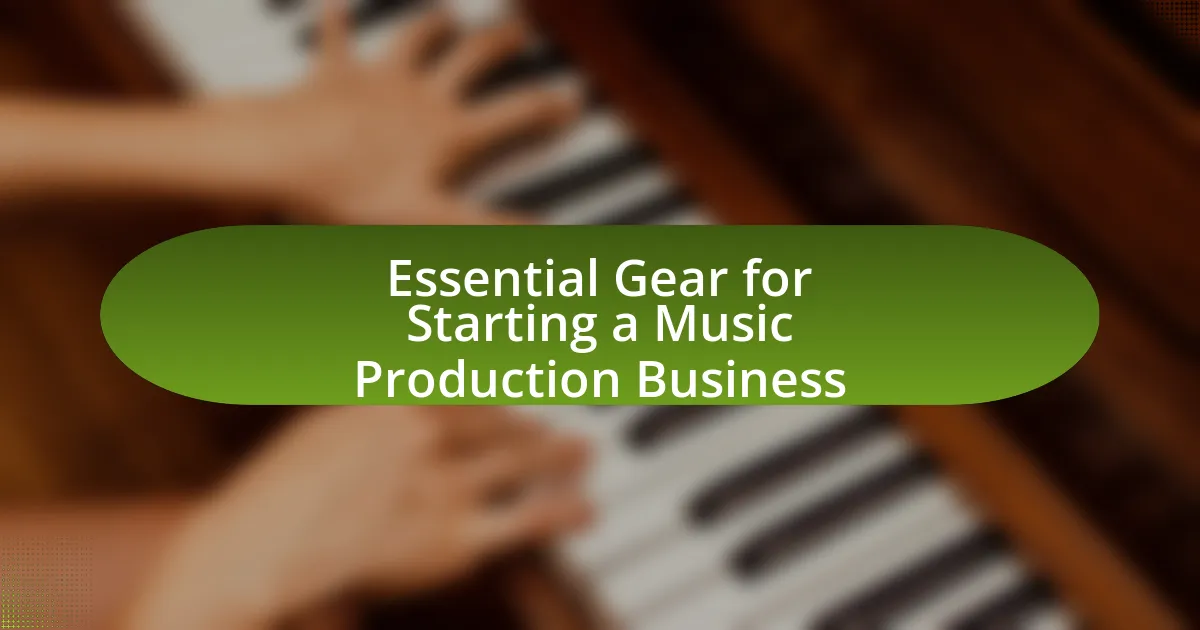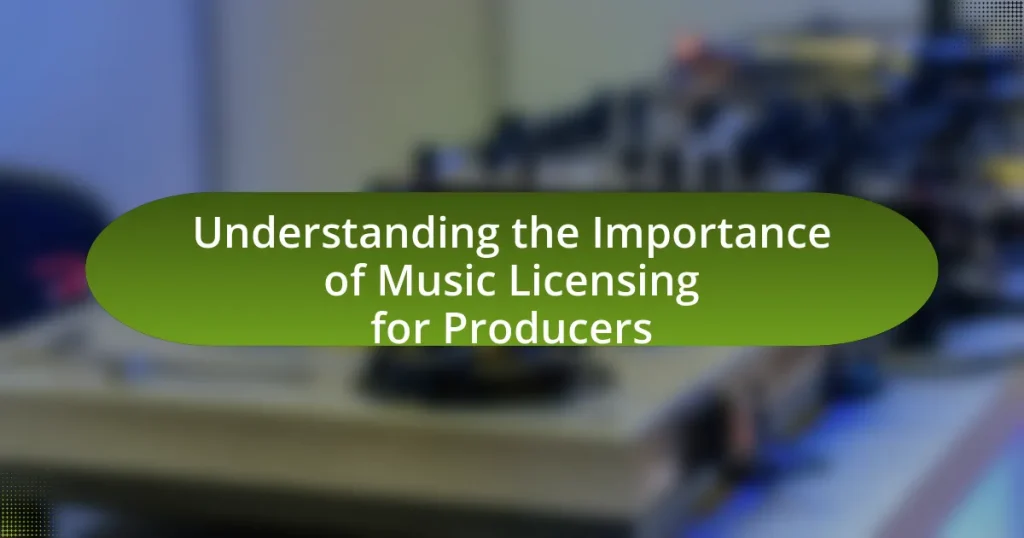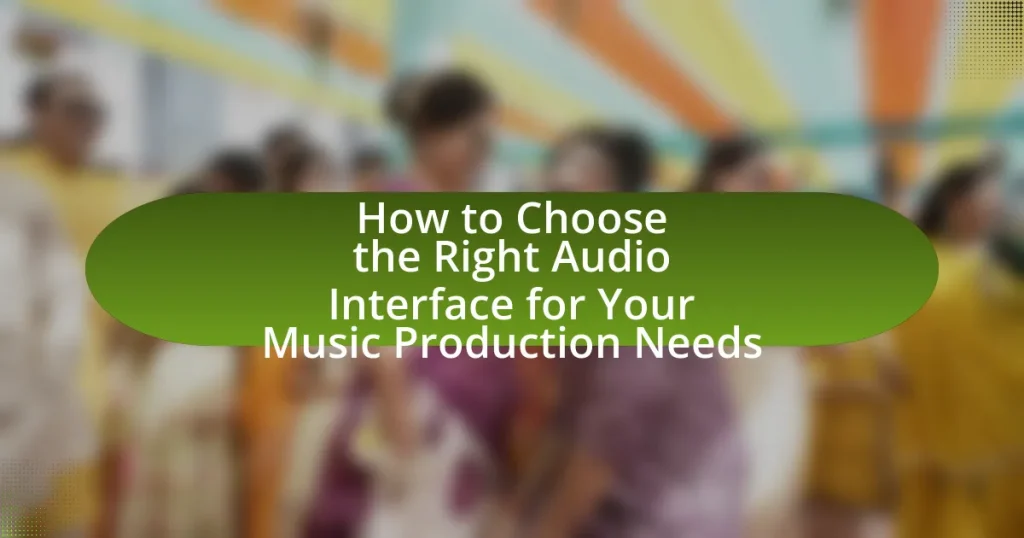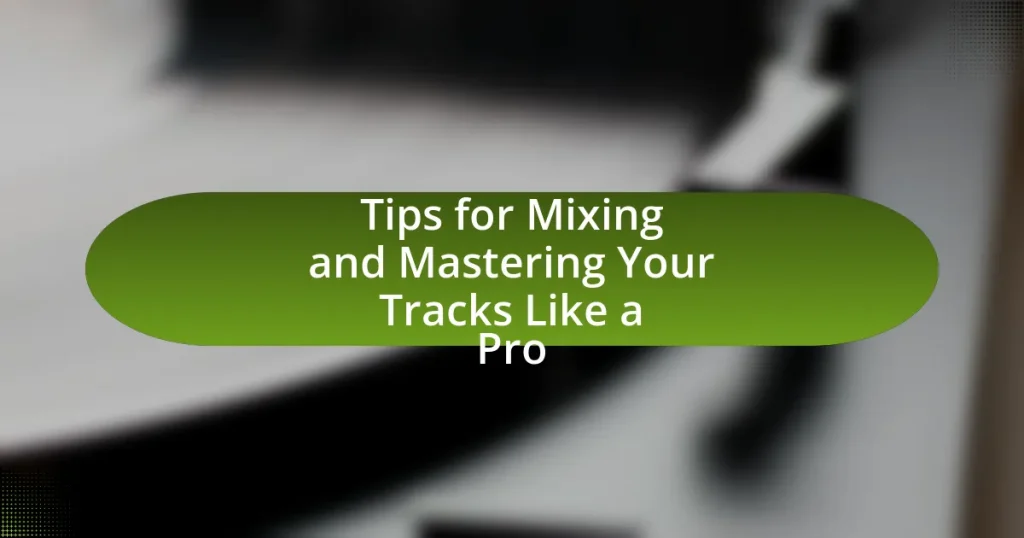The article focuses on essential gear for starting a music production business, highlighting key components such as digital audio workstations (DAWs), audio interfaces, studio monitors, headphones, microphones, and MIDI controllers. It emphasizes the importance of having the right equipment to ensure high-quality sound production and efficient workflows, while also discussing the consequences of inadequate gear. Additionally, the article provides guidance on selecting the best equipment based on specific production needs and budget, as well as best practices for maintaining and troubleshooting gear. Overall, it serves as a comprehensive resource for beginners looking to establish a successful music production setup.

What is Essential Gear for Starting a Music Production Business?
Essential gear for starting a music production business includes a digital audio workstation (DAW), audio interface, studio monitors, headphones, and a MIDI controller. A DAW, such as Ableton Live or Pro Tools, is crucial for recording, editing, and producing music. An audio interface, like Focusrite Scarlett, enhances sound quality and connects instruments and microphones to the computer. Studio monitors, such as Yamaha HS series, provide accurate sound reproduction for mixing. High-quality headphones, like Audio-Technica ATH-M50x, are essential for detailed listening. A MIDI controller, such as Akai MPK Mini, allows for easy input of musical ideas. These components are foundational for effective music production, ensuring professional results.
Why is having the right gear important for music production?
Having the right gear is crucial for music production because it directly impacts the quality and efficiency of the creative process. High-quality equipment, such as audio interfaces, microphones, and monitors, ensures accurate sound capture and playback, which is essential for producing professional-grade music. For instance, a study by the Audio Engineering Society highlights that using superior microphones can significantly enhance vocal clarity and detail, leading to a more polished final product. Additionally, the right software and hardware setup can streamline workflows, allowing producers to focus on creativity rather than technical issues, ultimately resulting in a more effective music production process.
What are the consequences of inadequate equipment in music production?
Inadequate equipment in music production leads to poor sound quality and limited creative capabilities. When producers lack essential tools such as high-quality microphones, audio interfaces, and monitoring systems, the resulting recordings often suffer from distortion, noise, and an inability to capture the full range of sound. This can hinder the overall production value, making it difficult to compete in a professional market where high standards are expected. Furthermore, inadequate equipment restricts the ability to experiment with different sounds and techniques, stifling creativity and innovation. Studies show that professional-grade equipment can significantly enhance the clarity and depth of audio, which is crucial for achieving a polished final product.
How does quality gear influence the final product?
Quality gear significantly enhances the final product by ensuring superior sound fidelity, reliability, and creative flexibility. High-quality microphones, audio interfaces, and monitors capture and reproduce sound with greater accuracy, which directly impacts the clarity and richness of the music produced. For instance, a study by the Audio Engineering Society found that professional-grade equipment can reduce distortion and improve dynamic range, leading to a more polished final mix. Additionally, quality gear often includes advanced features that facilitate better workflow and creativity, allowing producers to experiment and refine their sound more effectively.
What types of gear are essential for a music production business?
Essential gear for a music production business includes a digital audio workstation (DAW), audio interface, studio monitors, headphones, microphones, and MIDI controllers. A DAW, such as Ableton Live or Pro Tools, serves as the central software for recording and editing music. An audio interface, like Focusrite Scarlett, converts analog signals to digital, ensuring high-quality sound input and output. Studio monitors, such as Yamaha HS series, provide accurate sound reproduction for mixing. Headphones, particularly closed-back models like Audio-Technica ATH-M50x, are crucial for detailed listening. Microphones, including dynamic and condenser types, capture vocals and instruments effectively. MIDI controllers, such as Akai MPK Mini, facilitate music creation and arrangement. These components are foundational for producing professional-quality music.
What are the key categories of equipment needed?
The key categories of equipment needed for starting a music production business include audio interfaces, microphones, studio monitors, headphones, digital audio workstations (DAWs), and MIDI controllers. Audio interfaces are essential for converting analog signals to digital, allowing for high-quality recordings. Microphones capture sound, with various types suited for different applications, such as dynamic and condenser microphones. Studio monitors provide accurate sound reproduction, crucial for mixing and mastering. Headphones are necessary for detailed listening and monitoring. Digital audio workstations serve as the software platform for recording, editing, and producing music. MIDI controllers facilitate the input of musical data into the DAW, enhancing creativity and workflow. Each category plays a vital role in the overall music production process, ensuring professional results.
How do different types of gear serve various production needs?
Different types of gear serve various production needs by providing specific functionalities that enhance the quality and efficiency of music production. For instance, microphones capture vocals and instruments with varying degrees of sensitivity and frequency response, allowing producers to choose the right mic for the sound they want to achieve. Audio interfaces convert analog signals into digital format, ensuring high-quality sound recording and playback, which is essential for professional production. Additionally, studio monitors provide accurate sound reproduction, enabling producers to make informed mixing decisions. Each type of gear is designed to fulfill distinct roles in the production process, ensuring that the final output meets industry standards.
How can one determine the best gear for their music production business?
To determine the best gear for a music production business, one should assess their specific production needs, budget, and the genres they intend to work with. Evaluating the requirements helps identify essential equipment such as digital audio workstations (DAWs), audio interfaces, microphones, and studio monitors that align with those needs. For instance, a survey by Sound on Sound revealed that 70% of successful producers prioritize investing in high-quality microphones and audio interfaces, as these significantly impact sound quality. Additionally, researching user reviews and industry standards can guide choices, ensuring the selected gear meets professional benchmarks and enhances production capabilities.
What factors should be considered when selecting equipment?
When selecting equipment for a music production business, key factors include budget, compatibility, quality, and intended use. Budget determines the range of equipment available, influencing choices between high-end and entry-level gear. Compatibility ensures that all components work seamlessly together, which is crucial for a smooth production process. Quality affects the sound output and durability of the equipment, impacting the overall production value. Intended use guides the selection of specific tools, such as microphones for recording vocals or MIDI controllers for composing music. Each of these factors plays a vital role in establishing a successful music production setup.
How does budget impact gear selection?
Budget directly influences gear selection by determining the quality and quantity of equipment that can be purchased. A limited budget often necessitates prioritizing essential gear, such as audio interfaces and microphones, over high-end options, which can lead to compromises in sound quality and functionality. For instance, a study by the Music Industry Research Association indicates that producers with budgets under $1,000 typically opt for entry-level equipment, which may lack advanced features found in professional-grade gear. This financial constraint shapes the overall production capabilities and sound quality achievable in a music production business.
What are the common misconceptions about music production gear?
Common misconceptions about music production gear include the belief that expensive equipment guarantees better sound quality and that high-end gear is necessary for professional results. In reality, skill and creativity play a more significant role in music production than the price of the gear. Many successful producers create high-quality music using affordable equipment, demonstrating that talent and technique are more critical than brand names or costs. Additionally, some believe that all music production can be done solely with software, neglecting the importance of hardware like audio interfaces and microphones, which can enhance the recording process.
Why do some believe expensive gear guarantees better quality?
Some believe expensive gear guarantees better quality because higher-priced equipment often features superior materials, advanced technology, and enhanced durability. This perception is supported by the fact that professional-grade gear typically undergoes rigorous testing and quality control, ensuring reliability and performance that can meet industry standards. Additionally, many musicians and producers associate higher costs with prestige and brand reputation, leading to the belief that expensive gear will yield better sound quality and overall results in music production.
How can beginners avoid pitfalls in gear selection?
Beginners can avoid pitfalls in gear selection by conducting thorough research on their specific needs and budget before making purchases. Understanding the essential equipment required for music production, such as audio interfaces, microphones, and software, helps in making informed decisions. For instance, a study by the Music Producers Guild highlights that 70% of new producers regret their initial gear choices due to lack of knowledge. By prioritizing quality over quantity and seeking advice from experienced producers, beginners can ensure they invest in gear that enhances their production capabilities rather than complicating them.

What specific gear is recommended for starting a music production business?
To start a music production business, essential gear includes a digital audio workstation (DAW), audio interface, studio monitors, headphones, and a MIDI controller. A DAW, such as Ableton Live or Logic Pro, serves as the primary software for recording and editing music. An audio interface, like Focusrite Scarlett 2i2, converts analog signals to digital, ensuring high-quality sound input and output. Studio monitors, such as KRK Rokit 5, provide accurate sound reproduction for mixing. High-quality headphones, like Audio-Technica ATH-M50x, are crucial for detailed listening. A MIDI controller, such as Akai MPK Mini, allows for easy input of musical ideas. These components are foundational for effective music production, as they facilitate the creation, editing, and mixing processes essential for professional results.
What are the must-have items for a basic music production setup?
A basic music production setup requires a digital audio workstation (DAW), an audio interface, studio monitors, headphones, and a MIDI controller. The DAW serves as the primary software for recording, editing, and producing music, with popular options including Ableton Live and Logic Pro. An audio interface is essential for converting analog signals to digital, ensuring high-quality sound input and output. Studio monitors provide accurate sound reproduction, which is crucial for mixing and mastering tracks, while headphones offer a portable solution for monitoring audio. A MIDI controller allows for the input of musical notes and control of virtual instruments, enhancing creativity and workflow. These components collectively form the foundation of an effective music production environment, enabling artists to create professional-quality music.
What role does a digital audio workstation (DAW) play in music production?
A digital audio workstation (DAW) serves as the central hub for music production, enabling users to record, edit, mix, and produce audio tracks. DAWs provide a user-friendly interface that integrates various tools and features, such as MIDI sequencing, audio editing, and effects processing, which streamline the music creation process. For instance, popular DAWs like Ableton Live and Pro Tools are equipped with extensive libraries of virtual instruments and plugins that enhance sound design capabilities. The significance of DAWs in modern music production is underscored by their widespread adoption in professional studios and home setups alike, facilitating the work of artists, producers, and sound engineers in creating high-quality music efficiently.
Which audio interfaces are best for beginners?
The best audio interfaces for beginners include the Focusrite Scarlett 2i2, PreSonus AudioBox USB 96, and Behringer UMC22. These interfaces are user-friendly, affordable, and provide high-quality audio recording capabilities. The Focusrite Scarlett 2i2 is widely recognized for its excellent preamps and ease of use, making it a top choice for newcomers. The PreSonus AudioBox USB 96 offers solid performance and comes with a comprehensive software bundle, which is beneficial for beginners. The Behringer UMC22 is an economical option that still delivers decent sound quality, making it accessible for those just starting out in music production.
What accessories enhance the music production experience?
Accessories that enhance the music production experience include studio monitors, audio interfaces, MIDI controllers, headphones, and acoustic treatment panels. Studio monitors provide accurate sound reproduction, essential for mixing and mastering tracks. Audio interfaces improve sound quality and connectivity between instruments and computers, allowing for professional-grade recordings. MIDI controllers facilitate the creation of music by enabling users to play and manipulate virtual instruments easily. High-quality headphones offer detailed sound for critical listening and editing. Acoustic treatment panels reduce unwanted reflections and improve the overall sound quality in a recording space. These accessories are crucial for achieving a polished and professional sound in music production.
How do studio monitors differ from regular speakers?
Studio monitors differ from regular speakers primarily in their design and purpose, as studio monitors are engineered for accurate sound reproduction while regular speakers are often designed for enhanced bass and overall enjoyment. Studio monitors provide a flat frequency response, meaning they reproduce sound without coloration, which is essential for mixing and mastering music accurately. In contrast, regular speakers may emphasize certain frequencies to create a more pleasing listening experience, which can distort the true sound of the audio being played. This distinction is crucial for music production, where precision in sound is necessary for professional results.
What is the importance of headphones in music production?
Headphones are crucial in music production as they allow for accurate monitoring and mixing of audio. High-quality headphones provide a detailed sound representation, enabling producers to hear nuances in the mix that might be missed with speakers. This precision is essential for making informed decisions about levels, effects, and overall sound quality. Additionally, headphones facilitate a focused listening environment, minimizing external noise interference, which is vital during the creative process. According to a study by the Audio Engineering Society, using headphones can enhance the ability to detect phase issues and frequency imbalances, further underscoring their importance in achieving professional sound quality in music production.
How can one effectively build a music production gear collection over time?
To effectively build a music production gear collection over time, one should prioritize essential equipment based on specific production needs and budget constraints. Starting with a digital audio workstation (DAW) and a quality audio interface lays a solid foundation, as these are crucial for recording and mixing. Gradually, one can expand the collection by adding studio monitors, microphones, and MIDI controllers, which enhance the production capabilities.
Research indicates that investing in versatile gear that can adapt to various genres and styles is beneficial, as it allows for greater creative flexibility. For instance, a study by Sound on Sound highlights that producers who focus on quality over quantity in their gear choices tend to achieve better sound quality and efficiency in their workflow. Therefore, making informed purchases based on personal production goals and seeking second-hand options can also help in building a comprehensive collection without overspending.
What strategies can be used to prioritize gear purchases?
To prioritize gear purchases for a music production business, one effective strategy is to assess the specific needs of the production process and budget accordingly. This involves identifying essential equipment that directly impacts the quality of production, such as audio interfaces, microphones, and studio monitors, while considering the budget constraints. Research indicates that prioritizing gear based on immediate production requirements can lead to more efficient spending; for instance, a survey by Sound on Sound found that 70% of successful producers recommend investing first in high-quality microphones and audio interfaces to enhance sound quality. By focusing on the most impactful gear first, producers can maximize their investment and improve their production capabilities.
How can second-hand gear be a viable option for beginners?
Second-hand gear can be a viable option for beginners in music production due to its affordability and accessibility. Beginners often face budget constraints, and purchasing used equipment allows them to acquire quality tools without the high costs associated with new gear. For instance, a study by the National Association of Music Merchants indicates that entry-level producers can save up to 50% by opting for second-hand equipment. Additionally, many second-hand items are still in excellent condition, providing the necessary functionality for beginners to learn and create effectively. This combination of cost savings and quality makes second-hand gear an attractive choice for those starting in the music production business.

What are the best practices for maintaining music production gear?
To maintain music production gear effectively, regularly clean and inspect all equipment to ensure optimal performance. Dust and debris can accumulate on surfaces and connections, leading to malfunctions; therefore, using a microfiber cloth and appropriate cleaning solutions is essential. Additionally, storing gear in a controlled environment with stable temperature and humidity levels prevents damage from moisture and extreme temperatures. Regularly updating software and firmware for digital equipment enhances functionality and security. Furthermore, using surge protectors can safeguard against electrical spikes, which can harm sensitive electronics. These practices are supported by industry standards that emphasize the importance of maintenance for longevity and reliability in music production equipment.
How can proper maintenance extend the life of production equipment?
Proper maintenance can significantly extend the life of production equipment by ensuring optimal performance and preventing premature wear and tear. Regular inspections, cleaning, and timely repairs help identify potential issues before they escalate, thereby reducing the risk of equipment failure. For instance, a study by the U.S. Department of Energy found that routine maintenance can increase equipment lifespan by up to 30%, highlighting the importance of proactive care in preserving functionality and efficiency.
What cleaning techniques are recommended for different types of gear?
For cleaning different types of music production gear, specific techniques are recommended based on the equipment type. For microphones, use a soft, dry cloth to wipe the exterior and avoid moisture on the diaphragm. For headphones, clean the ear pads with a damp cloth and mild soap, ensuring they are completely dry before use. For audio interfaces and mixers, dust them regularly with a microfiber cloth and use compressed air to remove debris from knobs and faders. For keyboards and controllers, a gentle wipe with a damp cloth is effective, while ensuring no liquid seeps into the electronics. These techniques help maintain the functionality and longevity of the gear, as regular cleaning prevents buildup of dust and grime that can affect performance.
How often should gear be serviced or calibrated?
Gear should be serviced or calibrated at least once a year. Regular servicing ensures optimal performance and longevity of equipment, as recommended by manufacturers and industry standards. For instance, audio equipment like mixers and microphones may require more frequent checks, especially in professional settings where they are used extensively. Regular maintenance helps identify potential issues before they escalate, ensuring reliability during critical production periods.
What troubleshooting tips can help resolve common gear issues?
To resolve common gear issues in music production, first check all connections to ensure they are secure and functioning properly. Loose cables or faulty connections can lead to sound issues or equipment not powering on. Next, verify that all devices are powered and that any necessary drivers or software are installed and updated, as outdated software can cause compatibility problems. Additionally, perform a reset on the equipment, as this can clear temporary glitches. Regularly consult the user manuals for troubleshooting sections, which often provide specific solutions for common problems. These steps are effective because they address the most frequent causes of gear malfunctions, ensuring that the equipment operates as intended.
How can one identify and fix audio interface problems?
To identify and fix audio interface problems, one should first check the physical connections, ensuring that all cables are securely plugged in and undamaged. If the interface is not recognized by the computer, updating drivers or reinstalling the audio interface software can resolve compatibility issues. Additionally, testing the interface with different software can help determine if the problem lies within the interface or the application being used. Monitoring levels and settings in the audio software can also reveal misconfigurations that may affect performance. These steps are supported by common troubleshooting practices in audio engineering, which emphasize the importance of checking hardware connections and software settings to ensure optimal functionality.
What steps should be taken if studio monitors are not functioning correctly?
If studio monitors are not functioning correctly, first check the power supply and connections to ensure they are securely plugged in and operational. Next, inspect the audio interface or mixer settings to confirm that the output is directed to the monitors. Additionally, verify the audio cables for any damage or loose connections, as faulty cables can disrupt sound transmission. If issues persist, test the monitors with a different audio source to rule out problems with the original source. Finally, consult the manufacturer’s troubleshooting guide for specific issues related to the model, as this can provide tailored solutions based on known problems.
What are the key takeaways for starting a music production business with the right gear?
To start a music production business with the right gear, focus on acquiring essential equipment such as a digital audio workstation (DAW), audio interface, studio monitors, and quality microphones. A DAW, like Ableton Live or Pro Tools, serves as the central hub for music creation, while an audio interface ensures high-quality sound input and output. Studio monitors provide accurate sound reproduction, crucial for mixing and mastering, and quality microphones capture vocals and instruments effectively. Investing in these key components lays a solid foundation for a successful music production business, as they directly impact the quality of the final product.
How can beginners ensure they make informed gear choices?
Beginners can ensure they make informed gear choices by conducting thorough research on the equipment they need for music production. This involves reading reviews, comparing specifications, and understanding the requirements of their specific projects. For instance, a study by Sound on Sound highlights that 70% of successful producers prioritize understanding their gear’s capabilities before purchase. Additionally, engaging with online communities and forums can provide insights from experienced users, further guiding beginners in selecting the right tools for their music production needs.
What resources are available for ongoing education about music production gear?
Online courses, tutorials, and forums are key resources for ongoing education about music production gear. Platforms like Coursera, Udemy, and Skillshare offer structured courses on various aspects of music production, including gear usage and techniques. Additionally, YouTube hosts numerous channels dedicated to gear reviews and production tips, such as Produce Like A Pro and Point Blank Music School. Forums like Gearslutz and Reddit’s r/audioengineering provide community support and discussions on the latest gear trends and best practices. These resources collectively ensure that individuals can continuously learn and stay updated in the evolving field of music production.



